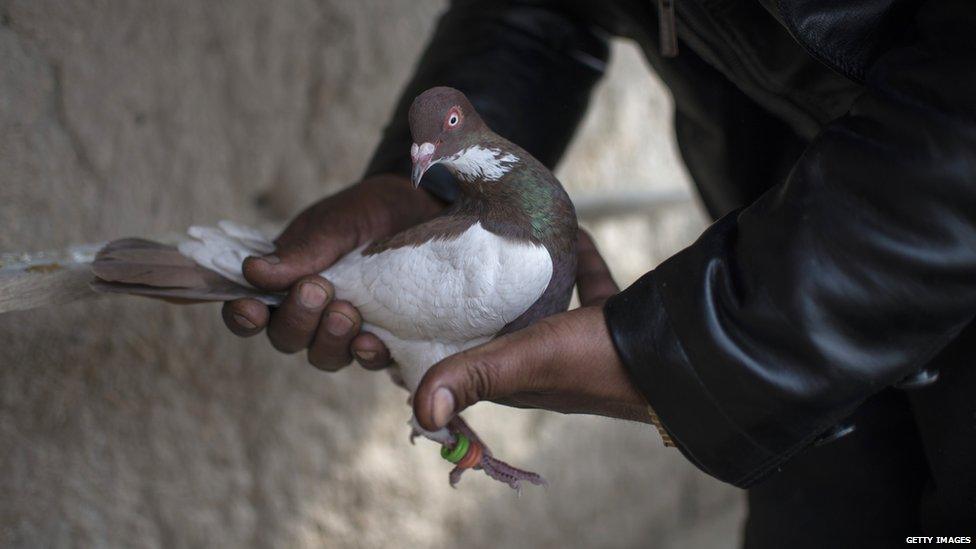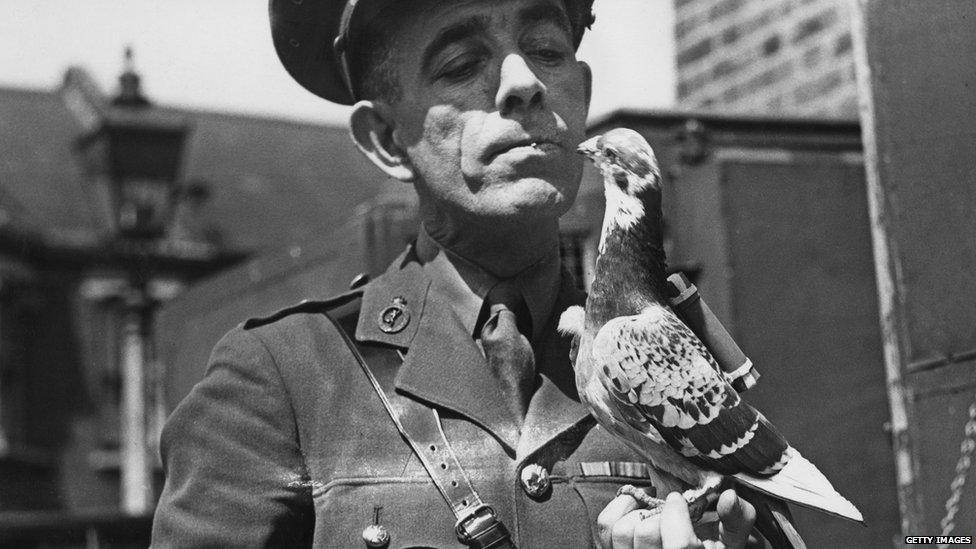Pakistani 'spy pigeon' arrested in India
- Published

A pigeon has been arrested by police in India on suspicion of being a spy from Pakistan.
The bird was seized on Thursday after being spotted carrying a "stamped message" on its body.
The message was written partly in Urdu, the official language of Pakistan. It also contained a Pakistani phone number, according to reports.
The bird was discovered by a 14-year-old boy in the village of Manwal, around two miles from the border.
He took it to the nearest police station where the bird was X-rayed.

A homing pigeon. Absolutely not a spy. Or is that what it wants you to think?
Although police confirmed nothing unusual was found they "have kept the bird in our custody", according to one senior local officer. The bird has been logged as a "suspected spy" in the area's official police diary.
"This is a rare instance of a bird from Pakistan being spotted here. We have caught a few spies here. The area is sensitive, given its proximity to Jammu, where infiltration is quite common," local police superintendent Rakesh Kaushal told the Times of India.
The area where the bird was found sits close to Jammu and Kashmir, an area which is claimed by both India and Pakistan, and is the scene of regular military exchanges.
But pigeons as spies? It wouldn't be the first time.
In fact until relatively recently carrier pigeons were the safest way of transmitting secretive information. You can't hack into a bird, and they blend into the background well. In fact, animals have a rich history as spies.
The Bletchingley pigeon
In 2012, David Martin was ripping out his fireplace at his home in Bletchingley, Surrey. Inside, he found a carrier pigeon with a coded message in a capsule on its leg.
Historians think the bird was almost certainly dispatched from Nazi-occupied France in June 1944, during the D-Day landings.

Home? Yes sir, right away sir

Is it a bird? Is it a plane? No, it's a bird IN a plane!
The contents of the message were a complete mystery, though. It was passed to Government Communications Headquarters (GCHQ) in the hope a professional codebreaker could decipher the words.
In the end the message was so well disguised the government had to call on second world war cryptographers to come out of retirement to help.
The message was eventually cracked months later by a Canadian team, who discovered it was sent by a British paratrooper, Sergeant William Stott, who had been parachuted in behind enemy lines. The message said that he had landed and was checking in with RAF Bomber Command.
Operation 'Acoustic Kitty'
In the 1960s the CIA spent more than $20m (that's over £100m in today's money) creating a cyborg cat spy. The cat was surgically altered so that it had a battery pack in its chest, a microphone in its ear, and an antenna running along its spine and tail.
The cats were trained to brush up against the legs of Soviet embassy staff, therefore recording and transmitting their conversations.
It was ambitious, but useless. It's widely believed the first time a cat was put into the field, it was immediately hit and killed by a taxi.
Historians have since disputed this, saying the cats couldn't be effectively trained and the programme was cancelled as a result.

Again, this cat is not a spy. It's just a bit poorly
The mayor of Hartlepool
In 2002, H'Angus the Monkey, the town's football mascot, was elected mayor of Hartlepool.
Under the suit was a man called Stuart Drummond, who operated as mayor in his true capacity.

H'Angus in 2013
But why H'Angus the Monkey?
Legend has it that during the Napoleonic wars (1803-1815), a monkey was found on the beach in the North East England town after a French ship was wrecked off the coast.
Since the locals had never seen a Frenchman before and the monkey couldn't answer their questions, they assumed the monkey was both a Frenchman and a spy and executed him. The people of Hartlepool have slightly been known as "monkey hangers" ever since.
The story probably isn't true, though. It's most likely to come from a 19th century parody called The Monkey Song.
Follow @BBCNewsbeat, external on Twitter, BBCNewsbeat, external on Instagram and Radio1Newsbeat, external on YouTube and you can now follow BBC_Newsbeat on Snapchat